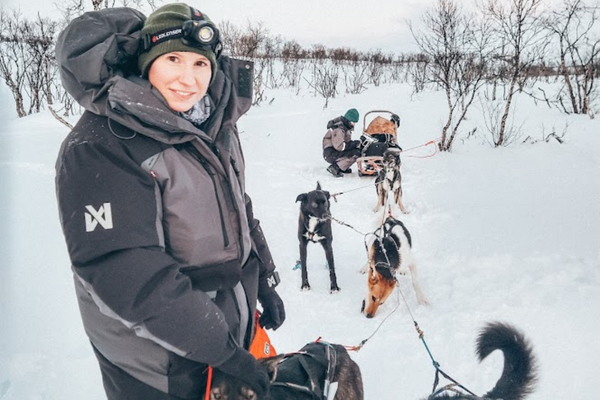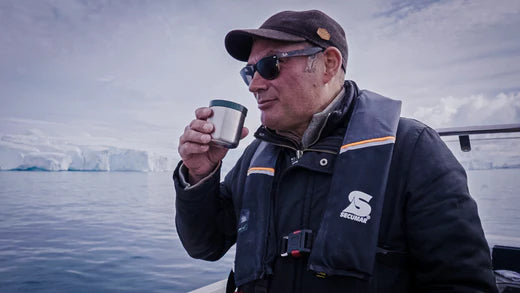
It’s no secret that Stanley is made to last—and it’s not unheard of to see a Stanley vacuum bottle still keeping coffee warm 50 years after it rolled out the factory. With that in mind, our new series ‘Stanleys in the Wild’ tells the stories of your indestructible Stanleys—the places they’ve been and the things they’ve seen.
To start things off, we’re taking a trip to the Arctic with dog-sledders Willem and Steffi. Since 2014 these two and their team of Alaskan huskies have been trekking across the lower Arctic—with their faithful Stanley bottle in tow. Keen to find out more, we talked to them about hot drinks, cold weather and their love for this unique mode of transport…
How long have you had your Stanley Classic Legendary Bottle?
I don´t know for sure—I think it might be around 12 years. The Stanley has been part of our equipment since our early days of adventure. Before dogsledding we were into mountaineering and hiking all over Scandinavia and Stanley was always with us.
We imagine it comes in pretty handy up there. What do you use it for?
Mainly for hot water and coffee. We are both totally coffee addicted and like to take a break on the trail, watch the dogs eating snacks and cooling down while having a good hot coffee.
The Stanley is by far the best choice for us when it comes to isolation for hours in arctic climate, but it's also great for preparing hot water and carrying it outdoors. That way, we can be faster when it comes to preparing food for us humans. And being faster with eating means having more time for dog care which is super important when having a race or expedition.

As well as your Stanley vacuum bottle, what else do you pack for a dog-sled trip?
A lot. The sled bag can easily weigh around 40 kg. First there’s the obligatory outdoor equipment like GPS, power banks, an axe, a map, sleeping bag, emergency signal, duct tape, snow shovel, first aid kit. And then there are the spare parts for the sled, like ropes and gliders.
Our racing sled has a built-in tent which also weighs a bit and of course there is also always a lot of food around. Of course the goal is to travel light, but with a pack of up to 14 dogs, that's not always easy.
That makes sense. How important is good quality equipment during an expedition?
Essential. It doesn’t matter if you are out in heavy conditions or enjoying a great day with sunshine, good and reliable equipment is the key to success. I often compare it to insurance, which you don't have to think about until you are in a bad situation. Good quality equipment means you can focus on the experience and the adventure.
Going back, how did you both get into doing dog-sled expeditions in the first place?
Steffi and I got into dog-sledding around 2014. We had a sabbatical and travelled through north-eastern Europe—and at some point we found the opportunity to live and work on a small husky farm in northern Norway.

Our plan was to stay there for a month and then move on to Sweden, but from the moment we arrived at the farm we were hooked. There was the smell of a husky farm, the barking, all the dog’s faces and the excitement in their eyes… and then our host arrived some minutes later with all these winter clothes on, dressed like people I only knew about from my Jack London stories when I was a kid. That was the exact moment we both got into dog-sledding.
What’s special about dog-sleds? What sets them apart when compared to other ways to travel?
First there are the dogs—Alaskan huskies are bred to be super friendly to every dog or human, great runners and super reliable. But besides these ‘hard-skills’, when you take good care of them, they will accept you as a part of their pack and will interact with you as if you are one of them. And that of course is special.
Then there is the sled itself: Every dogsled is made by hand from skilled craftsmen and the techniques are still the same as they were 100 or more years ago. Expedition sleds are still made out of wood and the pieces are attached to each other with rope.
It's the combination of skill, trust and adventure. Dogsledding is a very calm and quiet way of travelling but at the same time it's a way of travelling where you are always totally exposed to nature. When you understand the dogs way of living and how they see the world, then it´s a magical experience. I once heard a saying in a video where a dog-musher said, "dogsledding lives at the intersection of skill and chaos," and that sums it up.
What sort of challenges can you expect to face whilst out in the arctic? It doesn’t exactly look like a walk in the park.
There are multiple things that might happen. One that always happens are snowstorms—you will face a storm when you are out. Then of course there are things like whiteouts where you don't see anything but white snow, and then a special arctic phenomenon is the "overvann"—which means water that is above frozen lakes or rivers and can push the thick layer of ice down. When facing overvann it is possible to stand in knee-deep water while there still is a thick layer of ice that holds the weight… a strange feeling.

When we’re outside with our own teams, temperature is a crucial factor—when the temperature drops below -25 degrees Celsius and there is a storm, freezing fingers, noses or cheeks are something to think about.
What’s your living situation like when you’re on an expedition?
It's just us and the dogs living outside. When we are lucky and find the mountain huts, we can set up a proper camp with long-lines and straw for the dogs, putting warm coats around them. But the days are of course filled up with work which means getting up early, searching and chopping wood, making dinner for the dogs, melting snow or digging for water under the snow. Then it’s late evenings and working on equipment or planning the next route.
Where do you sleep?
We always have a tent with us. You can either sleep in the tent which is built into the sled bag, take a jervenduk (which is something like a bivouac) and sleep outside, or of course use some of the old gamme—which are cabins for hunters. If possible we try to take routes that are near to mountain cabins so we can sleep inside.
That sounds like a good idea. What sort of stuff do you eat when you’re out?
Expedition meals are normally ready-made meals which are heated up with hot water but sometimes we like to take fresh stuff mixed with pemmican.
What’s that?
Pemmican is a mixture of dried meat, fat and spices. It's very durable and can easily be carried in vacuum bags. It was first made by the Cree people and is a source for high amounts of protein and, even more importantly, fat.

Sounds tasty. Your travels have taken you all over the Arctic—do you have a favorite memory from your expeditions?
The lower arctic region of north-eastern Finnmark is a very special place, with the whales down at the fjord, the reindeers and eagles up in the fjell. The feeling of being in an untouched landscape and the indigenous Sami people around, the northern light and the community of mushers is very special.
The best memory is just a feeling: the feeling when we have planned for months for an expedition and then we finally pull the security rope and head out of the basecamp to explore. This moment is maybe the best moment in my life—it's a moment where you know that you made the right decisions to make a dream, an expedition or a race come true and a moment of total freedom where everything can happen.
Wrapping things up, what’s your favorite hot drink when you’re out in the Arctic?
Of course a good coffee is always great, but I would also take a glögg in the evening and enjoy it outside while watching the dogs and the Northern Lights.
Find out more about Willem and Steffi’s adventures here.
Have you also got a Stanley with a story to tell? We’d love to hear from you. Share your story here and bag yourself £100 to spend on our website.
Back to MY STANLEY



